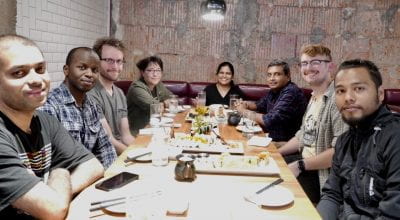Dr. Christine (Christy) Chow is a Professor in the Department of Chemistry.
Main Discipline(s):
Main Professional Societies:
Affiliation(s):
- Chemistry
- Biochemistry
- Bioinorganic Chemistry
- American Chemical Society
- American Society for the Advancement of Science
- RNA Society
- American Society for Biochemistry and Molecular Biology
- Professor, Department of Chemistry, Wayne State University
What are your undergraduate and graduate degrees in and from where?
I received an AB from Bowdoin College (Environmental Studies, Chemistry, German), MA from Columbia University (Organic Chemistry), and PhD from Caltech (Inorganic Chemistry)
Give a brief summary (250 words or less) of your current area of research.
My research group uses bioorganic, bioinorganic, and biophysical methods to study modified ribonucleic acids (RNAs). Natural RNAs contain four standard building blocks (nucleotides: G, C, A, and U) in addition to >150 modifications of those building blocks. My lab has been studying a modification known as pseudouridine. This modified nucleotide has received considerable attention recently because of its use in mRNA-based vaccines. We have been interested in how the modifications regulate RNA structure, stability, and interactions with small molecules such as antibacterials. More recently we have been looking at peptides as potential antimicrobials to treat drug-resistant infections. We also use inorganic compounds to target RNA or as probes for RNA structure.
How did you arrive at your current area of research?
Much of my research is driven by the interests and ideas of students working in my lab, but the work on pseudouridine was derived from my PhD work. I have been curious about its structural impacts and biological roles ever since I learned about it existence in RNA.
What do you see as a current emerging area of research that you would like to participate in and why?
I have worked on RNA targeting since I came to Wayne State in 1994. This area is finally gaining momentum in the scientific community, and several companies are now focusing on RNA as a drug target. The work we do in this area provides great training for students in multidisciplinary science.
Tell us your (one) favorite STEM research paper or book. Why it is your favorite?
When I am not reading journal articles, student reports or theses, or reviewing scientific papers, I prefer reading non-science books. However, while I was working from home due to COVID, I read KOJI Alchemy: Rediscovering the magic of mold-based fermentation (Rich Shih and Jeremy Umansky) and started doing some kitchen chemistry. I guess I was missing the lab a bit too much!
Do you have a favorite scientist, engineer or other role model? Who is it and why?
I have many favorite scientists and role models, but probably the most important is my PhD advisor, Prof. Jackie Barton. She taught me to be independent, but also how to trust and support other people on the team.
What do you do for fun outside of your role as a woman in STEM?
I enjoy hiking, biking, bird watching, gardening, cooking, and photography. When I have free time I am usually doing some activity with a camera in my hand.



